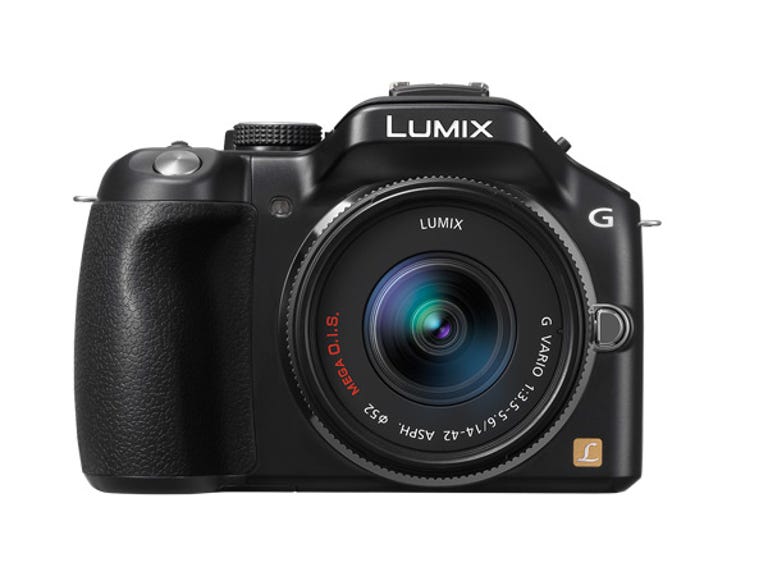 Why You Can Trust CNET
Why You Can Trust CNET Panasonic Lumix DMC-G5 review: Panasonic Lumix DMC-G5
There's nothing fundamentally wrong with the Lumix G5, but with a lack of "wow"-worthy features, it's just another interchangeable lens camera.
Panasonic has redesigned one of its top-end interchangeable-lens cameras (ILCs), giving it a more streamlined look in line with its range of superzoom models.
The Good
The Bad
The Bottom Line
Design and features
The G5 has been blessed with good looks and good ergonomics, making it a tempting proposition for any photographer looking at a higher-end ILC. A smooth grip lets the camera sit comfortably in the right hand, while the thumb can easily reach around and adjust settings with a range of buttons down the back panel.
A 3-inch 920,000-dot touchscreen flips out from the camera body, and can rotate around its side hinge. The G5 has an automatic sensor that switches between the screen and viewfinder when it detects that your eye is raised to the correct position.
The touchscreen has an interesting feature for those who like to pinpoint focus selection using fingers. Either when using just the screen or through the electronic viewfinder to compose a shot, simply touch around the screen to select your target anywhere around the frame.
A full suite of manual exposure controls are available from the mode dial, while fine tuning is done with the rear rotating dial. Turn it to get aperture adjustment, or click and turn it for shutter-speed control.
For photographers who are not quite ready for the world of manual, Panasonic provides intelligent automatic mode. Press the dedicated button at the top of the camera and away you go. When a power zoom lens is attached to the camera, the lever at the top can be used to control the zoom mechanism, rather than having to reach around for one on the barrel itself.
There is also a scene guide for beginners, which has a collection of 23 photos taken by professionals. Select the photo that most closely emulates the scene you want to take a photo of, and the camera will automatically set everything up for you. If this isn't enough to play with, there are a range of colour modes to add effects like soft focus, monochrome, cross-process and toy camera to your images.
Adjacent to the pop-up flash is a stereo microphone for recording audio, which is all the sound control you get. There's no external microphone jack supplied for attaching an external mic.
Full HD video recording at 50p is available in AVCHD, which is an upgrade from the interlaced offering on this camera's predecessor, the Lumix G3. The G5 also comes with an electronic shutter, which allows for near-silent shooting in situations where noise isn't tolerated.
Compared to

| Samsung NX20 | Olympus OM-D | Canon EOS M | Panasonic Lumix G5 |
|---|---|---|---|
| 20.3-megapixel APS-C CMOS sensor | 16-megapixel Four Thirds Live MOS sensor | 18-megapixel APS-C CMOS sensor | 16-megapixel Four Thirds Live MOS sensor |
| 3-inch articulating AMOLED screen | 3-inch flip-down OLED touchscreen | 3-inch flip-down LCD screen | 3-inch articulating LCD touchscreen |
| Full HD video (1080/25p) | Full HD video (1080/60i) | Full HD video (1080/24p) | Full HD video (1080/60p) |
| 15-point AF | 35-point AF | 31-point AF | 23-point AF |
Performance
The G5 has a number of continuous shooting modes. Both SH and H modes disable Live View while shooting. In SH mode (JPEG only, electronic shutter), the camera takes a burst of 40 images at 15 frames per second before stopping to process them. In H mode (JPEG) the G5 takes 8fps and slows to process the burst after 12 frames have been taken. Both M and L modes keep Live View active during shooting, but slow the frame rate down.
Panasonic rates the battery for 320 shots.
Image quality
The G5 delivers image quality that's on par with earlier Panasonic G-series cameras. Colour rendition is good on default settings, while the camera displays a good dynamic range across common shooting situations. Again, as we found with the GF5, the kit 14-42mm power zoom lens isn't as sharp as we would like, and it definitely does not eke the best from the sensor. Much better (and sharper) results can be found when using other Lumix lenses.
A comparison of the RAW and JPEG files produced by the G5. As you can see, the RAW file shows up a lot more detail and provides more latitude for the photographer to work with in post-processing, particularly as the ISO sensitivity climbs and the JPEG processing starts to smear some detail.
(Credit: CBSi)
Exposure is generally on the mark for most situations, but does tend to underexpose ever so slightly in bright and contrast-full situations. Automatic white balance is accurate.
Video quality is very good from the G5, thanks to the upgrade to progressive recording. The video image is sharp, while sound is well defined and separated nicely thanks to the stereo microphone.
Users also get the selection of AVCHD at 1080/60p or 1080/30p, or AVCHD Lite at 720/60p. MP4 recording is also available, and continuous autofocus is supported.
Image samples
Exposure: 1/250, f/5.6, ISO 160 | Exposure: 1/80, f/4, ISO 1600 |
Exposure: 1/125, f/4.5, ISO 160 | Exposure: 1/500, f/11, ISO 160 |
Conclusion
The G5 has a range of improvements from the previous model — but it's not quite enough to make it worthy of the flagship title that it gets by virtue of being one of the high-end models in the Panasonic ILC range. Its feature set is up to par with those offered from competing models, but without any particular wow factor it becomes hard to differentiate from all the other cameras that are vying for your cash.


